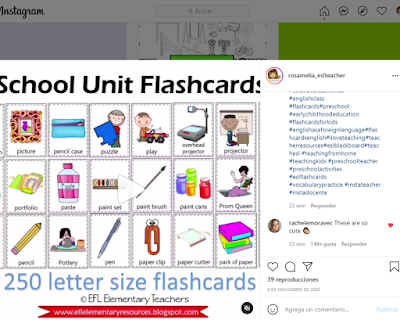This
is the second part of the family unit resource. All will be one product. LINK:
https://www.teacherspayteachers.com/Product/Family-Flashcards-worksheets-and-more-for-Elementary-ESL-students-4841832
It is available in this other store:
Watch the video of the complete resource:Family members have a name.Use the possessive adjectives to introduce them.
Teacher: Who is this?
Students: Mother!
Teacher: What’s the mother’s name?
Students: Patricia. Her name is Patricia.
Continue
with all the family members.
Family
members have facial features.
Use the flashcards to describe the parts of the face.
Teacher: Who is this?
Students: Mother!
Teacher: Look at the mother! She has curly black hair. She
has black eyes.

Insert each flashcard into a clear plastic sheet and
using dry erase markers have the students label the facial features.
Students will understand how to use adjectives to express emotions.
I made a set of worksheets
that can be done in a group to color in the facial features and the emotions. Each
student can do one family member and then present to the class.
Or,
they can exchange with other students in the group and read. The teacher can
start a question and answer session.
Teacher: Who is this?
Students: The aunt!
Teacher: What’s her name?
Students: Her name is Lucy.
Teacher: Does she have brown hair?
Students: Yes, she does!
Teacher: Does she have blue eyes?
Students: No, she doesn’t. She has green eyes.
Teacher: Is she happy or sad?
Students: She is happy!
I also added a smaller set just in case you needed it.
After the little faces are done, you can sort the
family members by hair color.
Or sort by eye color.
Family Unit Pocket
charts can be used for reading purpose and have them work in
pairs to complete the reading task.Use these to ask yes/no questions: Is this Father?
If you do not have a pocket chart, try making the
sentences on the desk or a mat.
Make it fun to read using a pointer. I had this old one
from the Dollar Tree store.
I found these dry erase cutouts and use it for writing
the sentences in the pocket charts.

You can make your own sentences for the pocket charts.
I used these strips that I had from the Dollar Store.
Or cut the words and have the students make the
sentences.
To end this part of the Family Unit I made a game board.
The golf balls are the markers for each student, I
placed a clip behind each ball. The cards are light green (female) or dark
green (male) depending if landing on the dark or green part of the game board.
Students move along the board as they answer the questions correctly.

This resource is part of the Family Unit
BUNDLE: https://www.teacherspayteachers.com/Product/Family-Unit-BUNDLE-for-Kindergarten-and-Elementary-ESL-6704385
Follow me!


















































